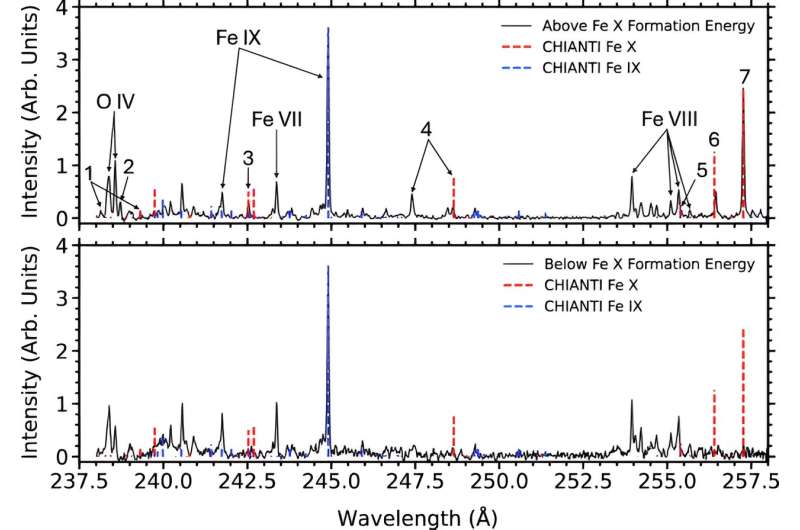This article has been reviewed according to Science X's editorial process and policies. Editors have highlighted the following attributes while ensuring the content's credibility:
fact-checked
peer-reviewed publication
trusted source
proofread
Researchers identify useful emission lines in the sun's outer atmosphere

When studying the solar spectrum, researchers often search for specific emission lines: prominent wavelengths emitted by ions as their electrons transition from higher to lower energy levels. Emission spectra of two iron ions, Fe IX and Fe X, are particularly useful for studying the sun's outer atmosphere. However, both of these spectra contain emission lines that can't yet be matched with known electron transitions, limiting the information which can be gathered from them.
In a study published in The European Physical Journal D, researchers led by Alexander Fairchild at Columbia University, U.S., carried out new measurements of these spectra in the extreme-ultraviolet (EUV) region, which enabled them to unambiguously identify the specific ion associated with these previously unmatched emission lines. Their results could enhance our understanding of several key properties of the sun's outer atmosphere.
Fairchild's team conducted their measurements at Lawrence Livermore National Laboratory in California, using the Electron Beam Ion Trap (EBIT-I). This facility creates and traps highly charged ions like Fe IX and Fe X using an intense electron beam, then records their resulting emission spectra.
The range of wavelengths studied by the team was especially useful as it allowed them to measure the ratio between two emission lines of Fe IX, predicted to be one of the best density indicators in the sun's outer atmosphere. It also includes an important Fe X emission line, induced by the interaction between the sun's atmosphere and its intense magnetic field.
To verify their results, the researchers compared them with Fe IX and Fe X emission lines modeled by CHIANTI, the database most widely used by solar physicists to analyze and interpret the sun's emission spectra.
For some emission lines, Fairchild's team found close agreement between CHIANTI's predictions and their experimental results. In other cases, they discovered previously unidentified emission lines in the Fe X spectrum, which will need to be added to CHIANTI to improve future predictions.
More information: Alexander J. Fairchild et al, High-resolution laboratory measurements of M-shell Fe EUV line emission using EBIT-I, The European Physical Journal D (2024). DOI: 10.1140/epjd/s10053-024-00891-x
Journal information: European Physical Journal D
Provided by SciencePOD





















